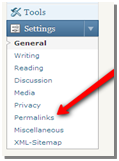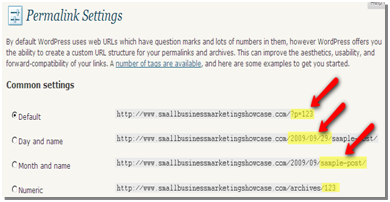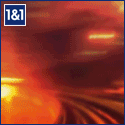Archive for Search Engine Optimization
Best WordPress Permalink Structure
Posted by: | CommentsMake Your New Blog Standout
So you’ve decided to convert your old, outdated website to a blog using a platform such as WordPress, but you’re not sure what options to pick to ensure your blog pages rank high with the search engines. One of the easiest things you can do is customize your site’s “Permalink” format.
The word “permalink” is short for the phrase “permanent link”. Once you make a blog entry (aka, post), it is given a name and that name gets turned into a permanent web address, or unique URL. Blogs are meant to be shared, quoted, linked-to and commented-on. It’s not surprising then, that once a blog entry is complete and posted, the URL or link needs to be permanent so when another website or blog links to it, it can be easily found on your site. If the link can’t be found the reader will get a 404 error saying the “page cannot be found”.
Permalinks can be configured many different ways. They can contain the author’s name, the date, blog category information and many other optional data elements. Now here’s the trick, search engines read blog entries like people do. So what’s most important to you, the date, the author’s name, or the content of the post? Hands down, the search engines like to find descriptive, keyword rich titles that accurately describe the contents of the post. Short, simple, clear and concise titling will rocket your posts to the top of the search engines and increase your blog traffic.
How to Set Your Permalinks
 Let’s look at how permalinks are changed in WordPress. First, log-in to your WordPress Admin site which should look something like www.yourblog.com/wp-admin. Of course, make sure you replace the words “yourblog” with your blog’s actual domain name. Next, look down the left side of the WordPress control panel. Near the bottom you’ll see the menu item “Settings”. Click on it.
Let’s look at how permalinks are changed in WordPress. First, log-in to your WordPress Admin site which should look something like www.yourblog.com/wp-admin. Of course, make sure you replace the words “yourblog” with your blog’s actual domain name. Next, look down the left side of the WordPress control panel. Near the bottom you’ll see the menu item “Settings”. Click on it.
Depending on what options have already been installed into your particular WordPress setup, your next set of menu selections may look slightly different than mine. Click the “Permalinks” menu option. This is the area where we are going to make our changes.
Notice that the default option contains some numbers at the end of the link. Using this method, each post is assigned a unique number in the database and can be easily and efficiently be found by the WordPress blogging platform. Unfortunately, just looking at the numbers, your readers have no idea what the post is about. Like I mentioned earlier, if YOU can’t read it, there’s a good chance that the search engines, and more importantly your readers, can’t read it either. So why does such an “ugly” naming convention get listed as the default? Because it is the most efficient for WordPress to archive, retrieve and deliver to the browser. Don’t forget that WordPress is just a fancy text database and as the number of visitors increase, it needs to be able to “serve” up all the requested pages very quickly. That’s a very important point, every option after the “Default” is slightly more difficult for WordPress manage, although usually more beneficial for the reader.
 The remaining 3 generic options allow some combination of date, post title, post category and custom numbering system. The two key takeaways here are: 1) there are lots of permanent address combinations available to build a Permalink that serves your needs (or suits your fancy); and 2) that WordPress prefers a number somewhere in the sequence, specifically, right after your domain address. In the examples below, it is some portion of the date.
The remaining 3 generic options allow some combination of date, post title, post category and custom numbering system. The two key takeaways here are: 1) there are lots of permanent address combinations available to build a Permalink that serves your needs (or suits your fancy); and 2) that WordPress prefers a number somewhere in the sequence, specifically, right after your domain address. In the examples below, it is some portion of the date.
Search Engine Page Ranking Tips
Click Here To Continue Reading ... Best WordPress Permalink Structure



